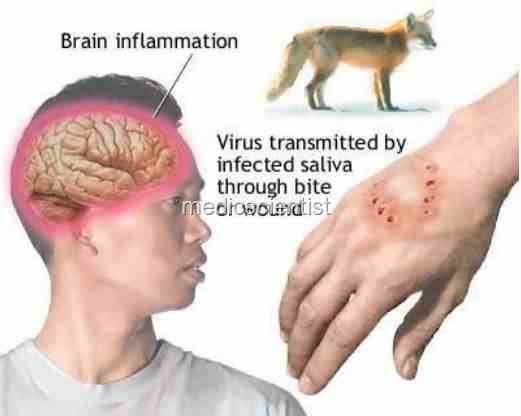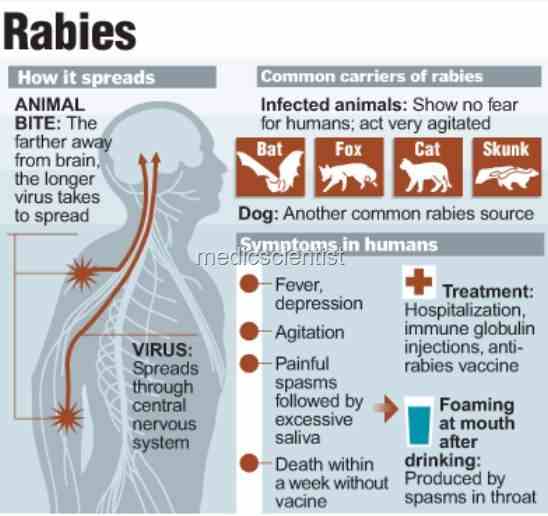Rabies Rabies is also called hydrophobia Incubation period is long Diagnosis Signs and symptoms with treatment
Rabies is a preventable zoonotic disease . A fatal infection of the central nervous system caused by the rabies virus. The etiologic agents are neurotropic RNA viruses belonging to the Family Rhabdoviridae, Genus Lyssavirus
- Human infection occurs as the result of a bite from a wild animal in which the virus is present.
- Rarely, it may be transmitted by inhalation of infectious aerosol particles or contamination of conjunctiva or other mucous membranes by the saliva of an infected animal.
 |
| Rabies Hydrophobia |
- Rabies is one of the oldest, best known, and most feared human diseases. It has the highest case fatality rate of any infectious disease.
- Causes encephalomyelitis resulting in death. Causative agent is Lyssavirus – RNA virus.
 |
| Rabies Causative agent is Lyssavirus – RNA virus |
TRANSMISSION OF Rabies —
- Almost all cases of rabies are transmitted from rabid animals through a bite. In rare cases, rabies results from a non-bite exposure
- Rabies is found almost exclusively in wild animals (e.g., raccoons, skunks, coyotes, foxes, and bats), which serve as reservoirs for infection.
- The long incubation period, before signs of rabies appear, is 3 to 12 weeks; this means that wild animals that are displaying no signs of the disease may still be infected, thereby increasing the risk of human infection.
- The saliva of infected animal contains the virus. Source of infection is saliva of infected animals. When animal bites or licks man, the virus is transmitted directly.
 |
| Clinical Features of Rabies Hydrophobia |
Clinical Features of Rabies Hydrophobia
- Early symptoms in humans usually are nonspecific and include fever, malaise, and headache.
- An acute neurologic syndrome of either encephalitic or paralytic rabies follows the prodrome and typically lasts for two to seven days.
- · There is hydrophobia
- · There is headache, malaise, sore throat, fever for 4 days
- Encephalitic (furious) rabies with the classic presentation of hydrophobia, aerophobia, pharyngeal spasms, and hyperactivity.
- Approximately 80 percent of patients with classic rabies have the encephalitic form.
- · There is widespread excitation of nervous system, sensory system, motor system, sympathetic system.
- · There is increased perspiration, fear of death, anger, irritability, depression.
- · Swallowing becomes difficult.
- · There is aerophobia or fear of air.
- · Hydrophobia is absent in animals.
- The classic symptom of hydrophobia (fear of water) is probably related to the painful contracture of the pharyngeal muscles that occurs during swallowing. Once clinical signs occur, the disease usually is fatal within days.
DIAGNOSIS OF Rabies —
-
Clinical diagnosis —
- The clinical diagnosis of rabies is straightforward in developing countries when a nonimmunized patient presents after a bite by a known rabid animal.
- Rabies should be considered in the differential diagnosis of patients presenting with acute progressive encephalitis regardless of a history of an animal bite or known exposure.
- The diagnosis of rabies is made in animals by a direct fluorescent antibody test on brain tissue.
-
Laboratory diagnosis —
- Antemortem diagnosis of rabies requires several specimens (eg, saliva, skin, serum, CSF) and multiple testing modalities, since the sensitivity of any single test is limited.
- In humans, brain biopsies, skin biopsies from the nape of the neck, corneal impression tests, and/or spinal fluid, blood, or salivary antibody tests are conducted.
 |
| Clinical Features Diagnosis Signs and symptoms of Rabies Hydrophobia |
Treatment of Rabies Hydrophobia
- no patient who has been exposed to rabies and not been vaccinated before the onset of symptoms has ever survived ,
- Physicians should contact the local or state health department to determine the need for postexposure prophylaxis.
- All wounds are vigorously cleaned.
- Isolation of patients Protection from light and cold
- Morphine in small doses repeatedly up to 30 mg
- Anticonvulsants
- IV fluids
- Intravenous immune globulin containing preformed antibodies and one dose of rabies vaccine are given immediately
- Vaccination – Chick embryo vaccine given in 6 doses 1 ml each on day 0, 3, 7, 14, 28 a Old 90 days.
- Vaccination is given to all persons with licks, scratches or bites by a rabid animal or an animal that dies in 10 days after contact.
- No cases of rabies have occurred when this protocol has been followed promptly after exposure.

